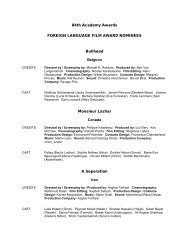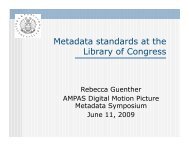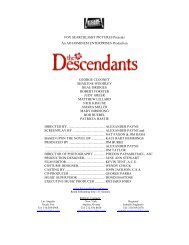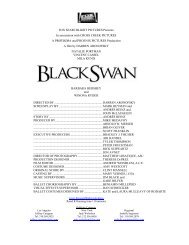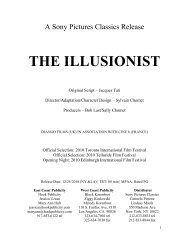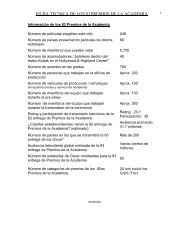Download Report - Academy of Motion Picture Arts and Sciences
Download Report - Academy of Motion Picture Arts and Sciences
Download Report - Academy of Motion Picture Arts and Sciences
Create successful ePaper yourself
Turn your PDF publications into a flip-book with our unique Google optimized e-Paper software.
photometric curves, they serve to show the comparative<br />
intensities <strong>of</strong> the various wave-lengths present.<br />
In Fig.5 the spectrogram at A is that {or acetylene<br />
<strong>and</strong> at B for noon sunlight. These are given as a<br />
basis <strong>of</strong> comparison in terms <strong>of</strong> which to judge the<br />
distribution <strong>of</strong> radiation in the spectra o{ flame arcs<br />
shown at C, D, E <strong>and</strong> F; C being that for a white<br />
flame arc, D the blue flame arc, E the yellow flame<br />
<strong>and</strong> F the red flame. It will be noted that the spectrum<br />
<strong>of</strong> the white flame arc resembles that <strong>of</strong> sunlight<br />
except that there is an appreciable enhancement<br />
<strong>of</strong> the radiation in the blue between 400 <strong>and</strong><br />
520 mp. It is difficult to compare the spectrum <strong>of</strong><br />
the yellow <strong>and</strong> red flame arcs with that <strong>of</strong> sunlight,<br />
but it is evident that there is a general predominance<br />
o{ intense lines in the long wave-length region between<br />
540 <strong>and</strong> 700 mp.<br />
Fig. 6 shows the distribution o{ energy in the<br />
radiation emitted by the Cooper-Hewitt mercury<br />
vapor lamp. This is a source <strong>of</strong> the line type, energy<br />
being emitted at the wave-length indicated by<br />
the heavy vertical lines, the relative intensity emitted<br />
at each wave-length being indicated by the height<br />
<strong>of</strong> the line.<br />
Now, having dealt with the characteristics <strong>of</strong> the<br />
radiation emitted by various light sources, we shall<br />
pass on to a consideration <strong>of</strong> the human eye as a<br />
sense organ responding to a stimulation by the ac-<br />
t40<br />
120<br />
rXSO<br />
d<br />
Huo<br />
1<br />
s<br />
I<br />
WAVE'LENGTH. rN mt<br />
FIGUR,E<br />
Diagram showing the relative amount <strong>of</strong> energy radiated at<br />
diferent wave-lengths by the Cooper-Hewitt mercurv<br />
vapor lamp.<br />
tion <strong>of</strong> radiant energy. The sensation produced<br />
when radiation falls upon the retina is re{erred to<br />
in general as light. This sensation has three distinct<br />
attributes: brilliance, hue, <strong>and</strong> saturation.<br />
Brilliance is that attribute oI any color in respect<br />
to which it may be classed as equivalent to some<br />
member <strong>of</strong> the series <strong>of</strong> grays ranging between black<br />
<strong>and</strong> white.<br />
Hue is that attribute <strong>of</strong> certain colors in respect<br />
to which they difier characteristically from a gray<br />
<strong>of</strong> the same brilliance <strong>and</strong> which permits them to be<br />
classed as reddish, yellowish, greenish, or bluish,<br />
etc.<br />
Saturation is that attribute <strong>of</strong> all colors possessing<br />
a hue which determines the degree <strong>of</strong> diflerence<br />
{rom a gray <strong>of</strong> the same brilliance.<br />
VI<br />
An object in the visual field is visible by virtue <strong>of</strong><br />
the contrast between it <strong>and</strong> its immediate surroundings<br />
or background. This contrast may be due to<br />
a difierence in hue (hue contrast), to a difierence<br />
in saturation (saturation contrast), or to a difierence<br />
in brilliance (brilliance contrast). In the case<br />
!<br />
I<br />
q<br />
E<br />
FIGURE<br />
VII<br />
Visibility cutve for high brightness levels.<br />
<strong>of</strong> a photographic reproduction such as a print or<br />
image projected on to a screen, since all hue contrast,<br />
<strong>and</strong> consequently all saturation contrast, is<br />
absent, visibility <strong>of</strong> object detail depends entirely<br />
upon the existence <strong>of</strong> a brilliance contrast. It follows,<br />
therefore, that the reproduction <strong>of</strong> detail by<br />
the photographic processes must be accomplished by<br />
reproducing as a brilliance contrast that contrast<br />
which in the object may be due to either a contrast<br />
<strong>of</strong> hue, saturation, or brilliance. This being the<br />
case, the visual function giving the relation between<br />
wave-length <strong>of</strong> radiation <strong>and</strong> the brilliance factor<br />
<strong>of</strong> the resulting sensation is <strong>of</strong> prime itnportance.<br />
This relationship is known as the visibility function<br />
<strong>and</strong> its form is obiained by measuring the magnitude<br />
<strong>of</strong> the brilliance attribute <strong>of</strong> the sensation produced<br />
when the same radiation intensity o{ various<br />
wave-lengths acts upon the retina. In Fig' 7 this<br />
visibility curve is shown. It is obtained by plotting<br />
as ordinates the magnitude o{ the brilliance sensation<br />
produced by constant energy o{ the various<br />
wave-lengths as indicated along the bottom <strong>of</strong> the<br />
figure. Thus we see that for a fixed amount <strong>of</strong><br />
energy the maximum sensation is produced by wavelength<br />
554 mp. From this point the curve falls<br />
rapidly for both shorter <strong>and</strong> longer wave-lengths,<br />
approaching zero at about 400 m/, on the one<br />
h<strong>and</strong> <strong>and</strong> 700 mp on the other. Thus it is evident<br />
that the visible spectrum is limited {or all practical<br />
purposes by wave-length 400 mpr, at the blue end <strong>of</strong><br />
the spectrum, <strong>and</strong> by wave-length 700 mp at the red<br />
end. A knowledge <strong>of</strong> this relationship is essential<br />
for the computation <strong>of</strong> the visual effect produced<br />
by radiation <strong>of</strong> any specified spectral composition,<br />
<strong>and</strong> is <strong>of</strong> fundamental importance in all problems<br />
dealing with the reproduction o{ visual tone values<br />
by the photographic processes. Used in conjunction<br />
L32l





